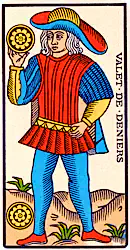The Tarot of Ideals



The Court Cards
The court cards are sometimes considered to represent real people associated with the current situation. They, more so than any of the other cards, form a literal, ordered society. This contrasts with the people in the trump cards such as the Empress and Emperor, who in context are more likely to represent abstract concepts. Alternative interpretations are possible; applied to oneself, a court card may represent a facet of your personality, or a role for you to play.
 |
The Page, or Valet, is a young assistant. Associated names are squire, knave, and jack. At different times he may have attended to a member of the nobility, or have been apprenticed to a knight. The basic concepts are youth, growth, and learning, as well as service and dependence on others. A page also suggests the idea of a messenger (“Paging Dr. Jones.”) Negative aspects may include immaturity, inexperience, or impulsivity. Pages (and knights) were male, and so represented historically; but modern readers are more likely to consider the concept to be gender-neutral. The lady-in-waiting was never included among playing cards, but may be something of a female analogy.
|
 |
The Knight is a fighter sworn to service to the king and/or queen. Unlike the Page, he is a grown adult, a trained professional, and more of an independent agent. He may be the first to respond to a challenge. He has been knighted, a rite of passage, and may have been entrusted with a specific task. The basic concepts are adult vigor, loyalty, and responsibility. Virtue, in this context called chivalry, also plays a central role; a knight (cavalier, caballero, gentleman) was expected to be a hero or role model (a “knight in shining armor”). Especially in modern times, non-warriors are sometimes knighted for exceptional achievement. Negatively, the Knight may represent conflict or rebellion, or failure of purpose. As with the Page, the modern concept is likely to be gender-neutral.
|
 |
Unlike the Page and Knight, the King and Queen are a gender-specific pair. Both rank and gender issues must therefore be taken into account. On the surface, the Queen represents mature female authority, possibly a maternal figure. Generalizing the concept, she may represent someone of either gender who embodies a “cups” style of leadership: receptive, nurturing, caring; someone who inspires affection in addition to loyalty. On the other hand, the established card order, like that of patrilineal societies, ranks the Queen lower than the King. She may therefore be taken as a second-in-command, vice president type of character, independent of gender; one who manages the home front while someone else fights the battles. The type of person who plays a role in the background out of proportion to appearances; “the hand that rocks the cradle,” “the power behind the throne.” (Note that sometimes there is a reigning queen.)
|
 |
The King represents mature male authority, possibly a paternal figure. Independent of gender, the King is a “rods” type of leader: active, assertive, dominating, the one who gives the orders. The King embodies mastery rather than support, control rather than influence; someone who may inspire fear in addition to loyalty. As to rank, the King is the top of the hierarchy, the boss, the CEO. Even though he wields the most power, he is expected to fight for the nation, is held responsible when things go wrong, and is the most likely target for assassination; “heavy is the head that wears the crown.” Different situations may call for different interpretations; the cards are intended to stimulate your own thinking and understanding.
|
In light of the above, how does one interpret the King of cups, or the Queen of rods, as the concepts seem to be contradictory? Looking first at the suit, the King of cups applies to the inner, emotional realm. The King may indicate the presence of, or need for, mastery of one’s emotions or inner state. From another angle, the Queen of rods may represent an assertive female leader.
A few more examples to illustrate the interpretation process:
The two of rods may refer to a joint venture, or a decision point where one of two actions must be taken. Negatively, it could indicate an impending battle.
The five of cups would indicate some sort of inner uncertainty or turmoil, perhaps leading to a breakthrough.
The six of swords suggests intellectual or spiritual harmony, or possibly getting along with one’s superiors.
The Knight of coins would indicate vigor or purpose in earthly affairs. Negatively, it may represent having to deal with protectors of the status quo.
The actual meaning depends on your own situation, and may take some thought. It is like looking at an inkblot; what do you see?





